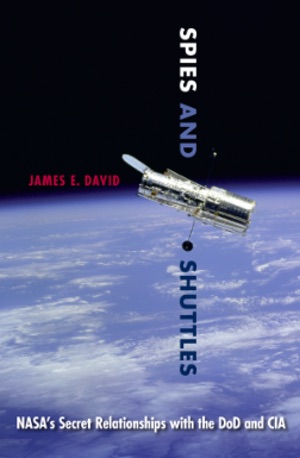Review: Spies and Shuttlesby Jeff Foust
|
| James David’s Spies and Shuttles offers one of the best analyses to date of the long, and often difficult, history of interaction between NASA and the national security community. |
As the title suggests, part of this book covers the cooperation between NASA and the military on the development and operation of the shuttle from the program’s inception in the early 1970s through the final Defense Department shuttle flights in the early 1990s. Much of that history is well known, including the demands on vehicle performance that the military placed on the shuttle that shaped its development. Those deliberations, including those involving the White House, are also covered in much greater detail in John Logsdon’s recent book on the Nixon Administration’s space policy (see “Review: After Apollo”, The Space Review, March 23, 2015).
While Logsdon’s book stops with the decision by Nixon to proceed with the shuttle, David examines the issues with its development and operations, from schedule delays and cost overruns to the challenges of handling operations of a civilian vehicle on a military mission (he notes that the Defense Department initially wanted media banned from the Kennedy Space Center for DOD shuttle launches; they later accepted them, but offered only a trickle of information about those missions.) As the shuttle failed to live up to its performance and launch frequency plans, the DOD pushed to restart development of expendable launch vehicles for its largest payloads, and then for all classes of payloads after the Challenger accident.
The book, though, is not just about NASA and military interactions with the shuttle. Much of the book covers the early history of NASA, including the roles that various national security agencies played in NASA’s programs. One of the biggest areas of influence the DOD had on NASA was in the area of Earth observations. The Pentagon placed significant restrictions on NASA’s early efforts there, concerned that it might reveal its classified reconnaissance capabilities. NASA was limited in the resolution of the images it could provide and often had to submit images taken during its crewed missions for a national security review.
At one point early in the history of the space program, the DOD was interested enough in human spaceflight’s role to perform reconnaissance that Secretary of Defense Robert McNamara proposed taking over all human spaceflight program, operating those that flew in Earth orbit and letting NASA handle human missions of the Moon. NASA’s administrator, James Webb, rejected what David calls a “brazen power grab,” as well as a later proposal by McNamara to jointly manage the Gemini program.
Not all interactions between NASA and national security agencies were conflicts. NASA received support from them in developing camera for use in lunar mapping missions. NASA also got considerable support in development of the Hubble Space Telescope, including the use of government-owned equipment at Perkin-Elmer’s facilities for building Hubble’s optical system (likely previously used for the HEXAGON reconnaissance satellites) and antenna boos developed by DARPA. The DOD also offered support in testing Hubble’s primary and secondary mirrors, but was turned down; had those tests been performed, it would have detected the flaw in Hubble’s mirror.
| NASA “did not always adhere to its guiding principles” of being a civilian agency, he concludes. “The civilian and national security space programs had too many common interests and activities to remain truly apart.” |
The book doesn’t cover post Cold War interactions between NASA and the military, which David says is due to a lack of declassified documentation describing those relationships. Many of the earlier concerns about Earth observation have subsided, as even private companies today provide high-resolution images of the Earth. The military has also lost interest in a role in human spaceflight. Thus, the opportunities for conflict or collaboration are limited today in any case, although they haven’t gone away. For example, in 2012 the NRO donated to NASA a pair of 2.4-meter optical systems likely originally built for reconnaissance satellites; NASA is expected to use one of them for a future space telescope, the Wide Field Infrared Survey Telescope (WFIRST).
David takes a straightforward approach telling this history, introducing topics at the beginning of each chapter and summarizing the findings at the end. At the end of the book, he argues that, in its collaborations and other interactions with the military, NASA “did not always adhere to its guiding principles” of being a civilian agency. “The civilian and national security space programs had too many common interests and activities to remain truly apart.” That should not be surprising: after all, NASA was also a creation of the Cold War, and its success in landing men on the Moon was one of the Cold War’s biggest victories for the US. This book, though, helps describe in much greater detail those links between NASA and other agencies.
